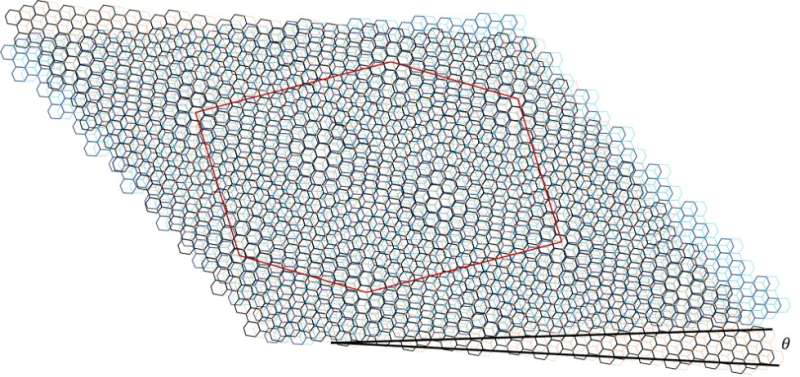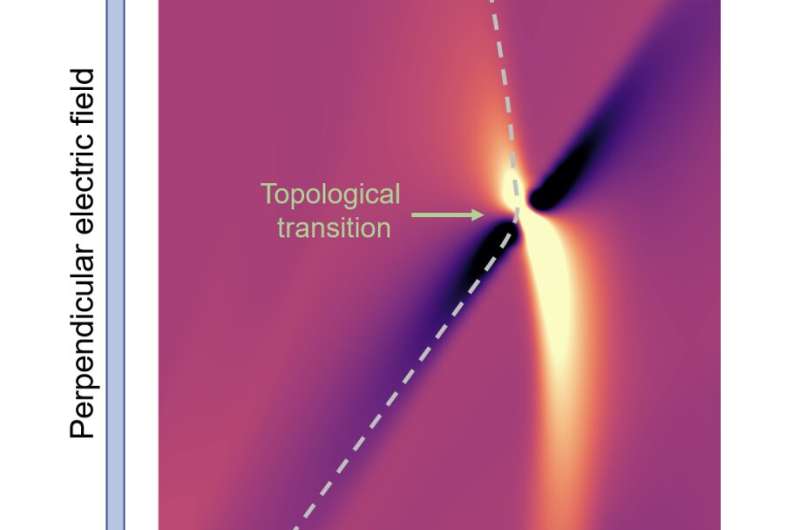A schematic of strained twisted double bilayer graphene (TDBG). Two bilayer graphene layers when rotated on top of each other by a small angle θ create large hexagonal moiré cells. The brown line outlines one such moiré cell. Strain distorts the moiré cells. Credit: Sinha et al.
The Berry curvature and Chern number are crucial topological qualities of a quantum mechanical origin characterizing the electron wave function of materials. These two elements play a very important role in determining the properties of specific materials.
While many studies have tried to determine how the Berry curvature and Chern number impact the properties of materials, detecting them in an experimental setting can be very difficult. Twisted double bilayer graphene, a material that consists of two stacked bilayer graphene crystals, is a particularly promising platform to manipulate the Berry curvature and valley Chern numbers of topological flat bands and thus to study their effects.
Researchers at Tata Institute of Fundamental Research, the Indian Institute of Technology, and Jawaharlal Nehru Centre for Advanced Scientific Research have been examining the tunable properties of twisted double bilayer graphene for more than three years. In their most recent study, featured in Nature Physics, they were able to directly detect a topological transition in a moiré superlattice by controlling the sign change in the Berry curvature dipole.
This paper builds on Prof. Mandar Deshmukh's previous works focusing on twisted double bilayer graphene. In one of their past studies, for instance, the researchers introduced strategies to detect the Berry curvature, which they then applied in their recent experiments.
"Before we started working on this project, Prof. Amit Agarwal's group was theoretically looking into different Hall contributions due to quantum mechanical effects," Subhajit Sinha, one of the researchers who carried out the study, told Phys.org. "On Christmas eve of 2020, he wrote to us regarding measuring the non-linear Hall effect in our samples. One of our twisted double bilayer graphene samples was cold in a cryostat, so we decided to collect measurements on it and see if we got anything. Perhaps some stars were aligned, because we did indeed measure some signal!"
After they validated their initial observations and measurements by performing several crosschecks, the team was able to determine with a high degree of certainty that they had in fact measured the non-linear quantum Hall effect in their twisted double bilayer graphene sample. They then performed other analyses in collaboration with Prof. Amit's research group to demonstrate that they had directly observed a topological transition.
In their recent experiments, Prof. Mandar's group at TIFR specifically measured the nonlinear Hall voltage in their twisted double bilayer graphene sample. This is a nonlinear voltage that can be driven by a perpendicular in-plane electrical current in the Hall-bar measurement.
The Berry curvature dipole (BCD) of TDBG, indicated via color. The dark purple color indicates a negative BCD, while the bright yellow color indicates a positive BCD. By increasing the magnitude of the perpendicular electric field, we can traverse along the dashed arrow to detect the sign change of the BCD. Sign change of BCD happens due to a topological transition. Credit: Sinha et al.
"Usually, the Hall voltage develops perpendicular to the flow of current when an external magnetic field is applied perpendicular to the sample's plane." Sinha explained. "Interestingly, the pioneering theoretical work of Sodemann and Fu showed that one can also have a Hall voltage in the absence of a magnetic field even in non-magnetic materials due to topological bands, and we measured this voltage."
Combined effect of a nonzero Berry curvature and small amounts of strain in twisted bilayer graphene system can give rise to what is known as the "Berry curvature dipole." This unique measurement generates a nonlinear Hall voltage that scales quadratically with the current applied to a material sample.
"We applied a low-frequency current and measured the Hall voltage at twice the frequency of the applied current to detect the nonlinear Hall voltage," Sinha said. "Then, we used a scaling analysis to detect a sign change in the Berry curvature dipole, indicating a topological phase transition."
Topological phase transitions are incredibly difficult to detect experimentally. Nonetheless, many theoretical and experimental studies have recently hinted at a transition in the topology of the bands of twisted double bilayer graphene. The recent work by the team offers a direct observation of this phase transition in an experimental setting.
"Using transport measurements, we detected this topological transition directly via a sign change in the Berry curvature dipole," Sinha explained. "This gives us an experimental handle for probing the band geometric physics and topological phase transitions simultaneously."
The findings gathered by this team of researchers could have very important implication for the study of topological phase transitions in twisted double bilayer graphene. In the future, the methods they employed can help in detecting topological transitions in other materials and systems.
"An immediate future direction for our work can be using our technique to map out the phase transition as a function of twist angle or stacking order," Sinha added. "In addition, we hope our method will also be emulated in other 2D or even 3D materials to characterize similar topological phase transitions. In general, the research interest in nonlinear Hall effects is growing due to its many advantages, one of which is probing the band geometric and topological properties of materials. We will have to wait and see the interesting avenues that nonlinear effects can access, as they unfold."
More information: Subhajit Sinha et al, Berry curvature dipole senses topological transition in a moiré superlattice, Nature Physics (2022). DOI: 10.1038/s41567-022-01606-y
Journal information: Nature Physics
© 2022 Science X Network

























